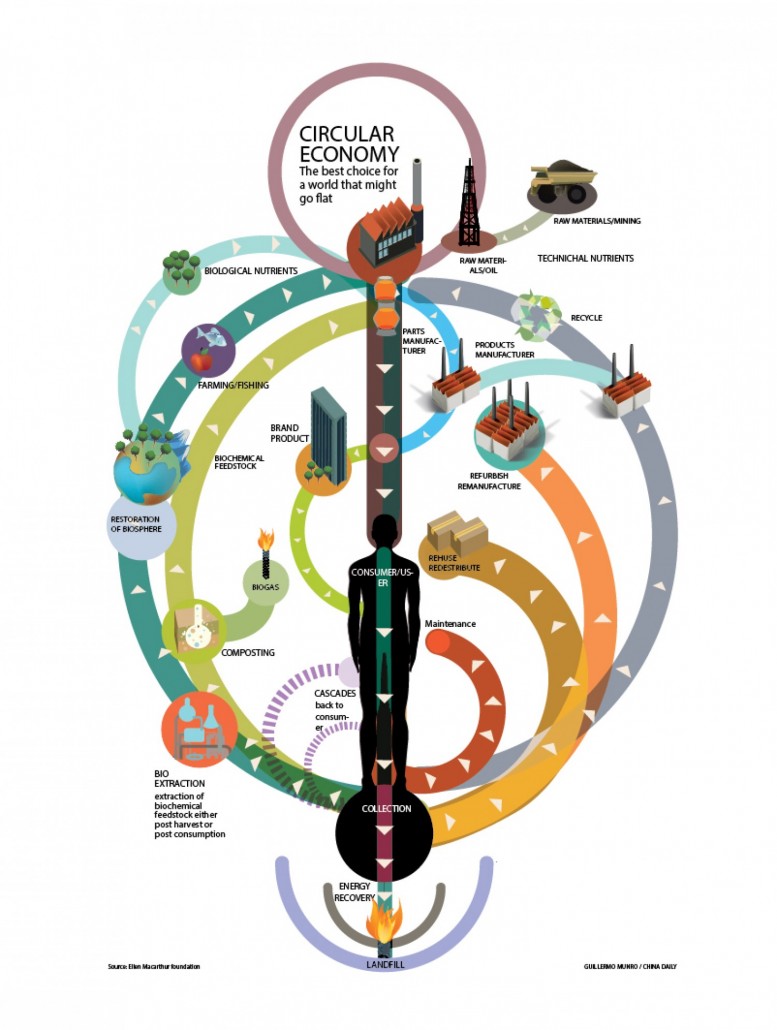Societal and environmental changes challenge business. Doing the same over and over again in a quickly changing economic environment and thereby expecting a positive outcome, cannot work. Albert Einstein defined this behaviour as ‘madness’.
Still most business models are structured this way – and many of them are already at the point of disruption. Digitalisation will not mean the solution to everything – it is merely going to be a tool for the best, and just a ‘band-aid’ for the not so good ones – as it will only cover the symptoms, not going the root of the problem. Resources like water, energy, land, and materials are becoming scarce. This causes not only economic pressure but also tension between regions and countries, thereby jeopardizing social peace and justice.
Change is inevitable and keeping material in the loop as long as possible makes the most sense. When Ellen MacArthur broke the world record for the fastest solo circumnavigation of the globe in 2005 she gained worldwide acknowledgment. Having spent 71 days and 14 minutes racing around the globe she claimed to have had plenty of time considering the importance of careful, sustainable resource management and energy use: „Our planet is comparable to a boat out in the ocean –we have to manage finite resources, because nothing will be renewed while we are out there.“
This is why in 2010 she launched the Ellen MacArthur Foundation, a charity that dedicates its work to the acceleration of the transition to a circular economy. Why circular? Because currently, and for the past decades, our economy is a linear one: we source – from mostly non-renewable resources – we produce and market products that people use and then dispose.
Today the foundation is one of the most acknowledged drivers to promote the the economic opportunities of a circular economy. Businesses around the world have started to adopt the principles of a circular economy, and are on their way to or already have shifted away from the traditional, linear way of production -take, make, and waste- to a circular approach -reduce, reuse, and recycle. It cannot be pointed out enough that this concept goes far beyond the re-cycling of waste materials (which is rather down-cycling in most cases). The current, far more elaborated approach to a regenerative, circular economy derives from cradle-to cradle principles, systems thinking, biomimicry, industrial sustainability, and the ‚blue economy’ and pioneers like Walter R. Stahel, Kenneth E. Boulding, Michael Braungart and others.
But while remanufacturing and refurbishment—key parts of the circular economy model—are no new concepts, they have the potential to become the game changer to new business models. Within a circular economy, products are meant to cycle through the economy many times, which means less waste and more opportunities to sell and resell a product. If a company recycles its own parts and generates its own supply of renewable energy, it becomes more self-sufficient, resilient, competitive, and usually more profitable. The consideration of ‘closing the loops’ can even lead to the transition of a product-based business model to a service-based one. This way they contribute to sustainability by using resources in a responsible manner.
Global corporations like Miele, Philips, Patagonia, Nike, IBM, Renault, IKEA or SMEs like Fairphone, Aquafil, MBA Polymers or Terracycle have already adopted the circular economy framework in response to increasingly volatile markets and advances in technology—consciously re-designing business models, products, and services so that they are restorative and regenerative.
On May 11th -12th, 2017, some of the pioneers will meet at the Circular Change Conference in Maribor/Ljubeljana, Slovenia to discuss ideas, needs and challenges of circular economy and the impact investment needed to enable businesses to join http://www.circularchange.com/events/conference-2017walking-the-talk-enabling-circular-transformation-2/

